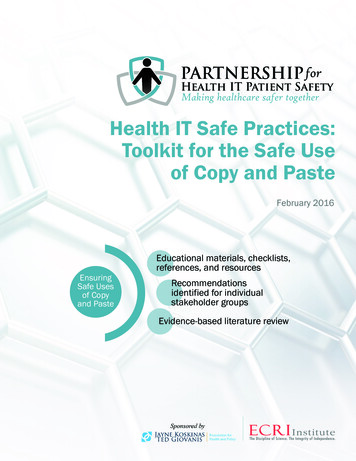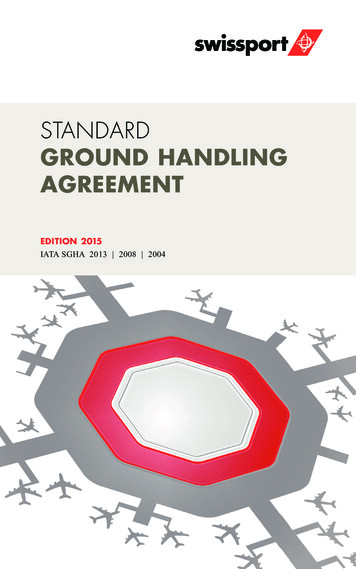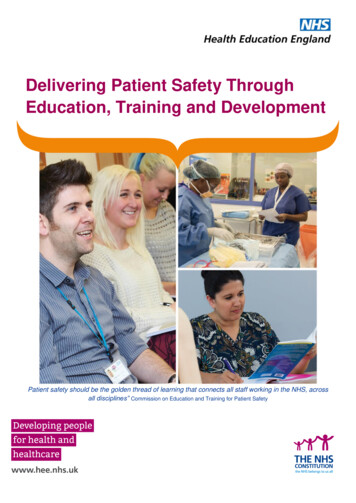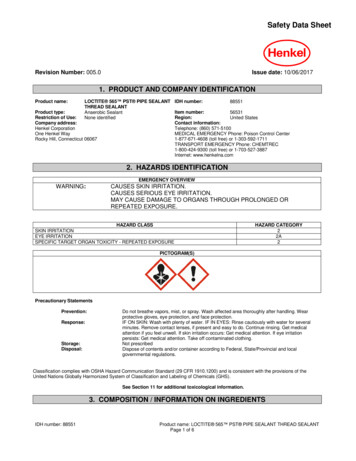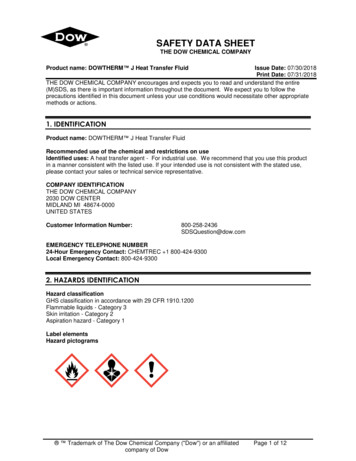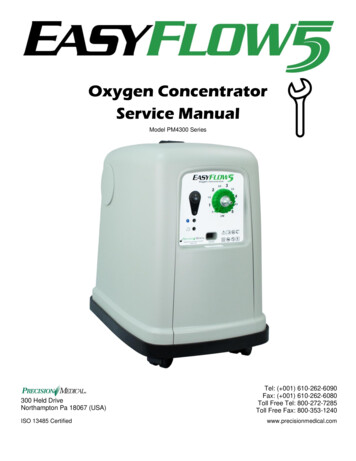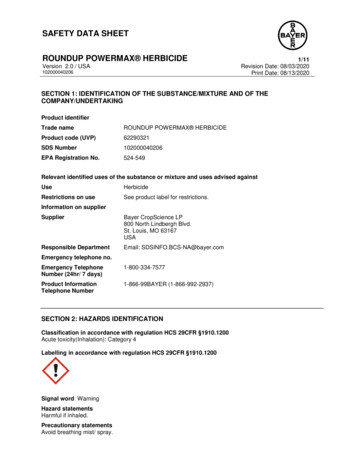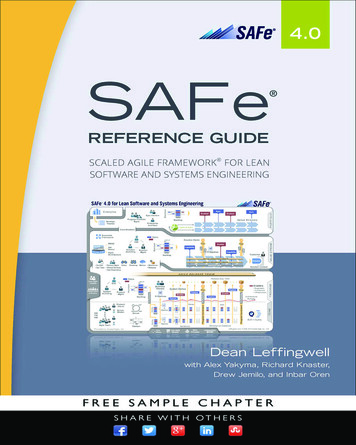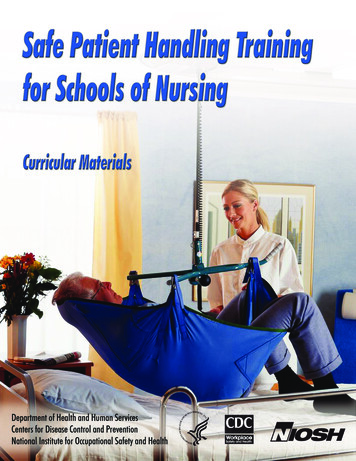
Transcription
Safe Patient Handling Trainingfor Schools of NursingCurricular MaterialsThomas R. Waters, Ph.D., NIOSHAudrey Nelson, Ph.D., VHANancy Hughes, Ph.D., ANANancy Menzel, Ph.D., University of Las Vegas, NVCurriculum developed in partnership with the National Institute for Occupational Safety and Health (NIOSH),the Veterans Health Administration (VHA), and the American Nurses Association (ANA)11RYHPEHU 2009
DisclaimerThis document is in the public domain and may be freely copied or reprinted.Mention of any company or product does not constitute endorsementby the National Institute for Occupational Safety and Health (NIOSH). Inaddition, citations to Web sites external to NIOSH do not constitute NIOSHendorsement of the sponsoring organizations or their programs or products.Furthermore, NIOSH is not responsible for the content of these Web sites.All web addresses referenced in this document were accessible as of thepublication date.Ordering InformationTo receive documents or other information aboutoccupational safety and health topics, contactNIOSH at1-800-CDC-INFO (1-800-232-4636)TTY: 1-888-232-6348E-mail: cdcinfo@cdc.govor visit the NIOSH Web site atwww.cdc.gov/nioshFor a monthly update on news at NIOSH,subscribe to NIOSH eNews by visitingwww.cdc.gov/niosh/eNewsDHHS (NIOSH) Publication No. 2009-127November 20094Safe Patient Handling Training for Schools of NursingCurricular Materials
Table of ContentsBackgroundPg 6Tool Kit for Safe Patient Handling and MovementTraining ProgramPg 8Implementing the Curriculum Module for the First TimePg 9Using the CurriculumPg 9Required Student ReadingPg 10Required Student Viewing and Listening (narrated slide show)Pg 10Required Student Laboratory ActivitiesPg 11Optional Background Didactic Material for FacultyPg 11Optional Laboratory MaterialsPg 14Quiz for Didactic SPHPg 15AppendicesAppendix A- VHA Safe Patient Handling and Movement AlgorithmsPg 16Appendix B - Assessment Criteria and Care Plan forSafe Patient Handling and MovementPg 38Safe Patient Handling Training for Schools of NursingCurricular Materials5
Backgroundindicates that adoption of safe patient handling (SPH)techniques, where nurses use assistive equipment duringtransfers, is effective in reducing the incidence of MSDsrelated to the handling of patients (Nelson et al., 2009).Educators at schools of nursing, however, continueto teach outdated techniques for patient handling. Theseapproaches rely on “proper” body mechanics—when therereally is no safe method to manually lift another adult humanbeing. The two-person lift and the hook-and-toss methodspersist as primary approaches taught to student nurses forlifting and moving patients (Nelson et al., 2009). Expertsand advocates of safety in handling patients consider thesetechniques unsafe (Nelson et al., 2009).Likely reasons that SPH techniques have notbeen widely accepted nor incorporated into fundamentalnursing education include the fact that (1) the knowledgebase for applying ergonomics to handling patients has onlyrecently evolved and (2) available evidence-based teachingmaterials and resources targeted toward faculty are lacking.This SPH curricular material, developed by cooperativeeffort among the National Institute for Occupational Safetyand Health (NIOSH), the Veterans Health Administration(VHA), and the American Nurses Association (ANA), willhelp instructors design training programs that encourage theuse of safe approaches to handling patients and contributeto the prevention of MSDs. History of frequent injuriesThe entire program is designed to be implemented High proportion of dependent patientsas a 1- or 2-day training module in schools of nursing. Lack of use of lifting equipment in good repairEach element of the program is designed to support and Low staffing levelsreinforce the other elements. The model for the SPHThe high physical demands associated with handling training program is focused on student learning, facultyand moving patients—who are getting heavier as obesity development in effective teaching and student assessment,rates in the United States climb—are probably the largest and it is based on three primary concepts:contributing factor to high rates of MSDs among practicingnurses. The aging of the workforce likely contributes to 1. Opinion leader(s) (Dean or Instructors) incorporatesthe SPH training program into the fundamentalsthe problem; the average age of a registered nurse in thenursing course.United States is approximately 47 years. Also contributingto the negative health consequences of manual handling 2. Instructor or school negotiates with practice settingsto support safer patient-handling practices throughis the shortage of nurses—Peter Buerhaus, a researcher atpurchasing equipment and instituting low-lift policies.Vanderbilt University Medical Center, has estimated thatthere will be a shortage of 285,000 nurses by the year 2020 3. Nursing schools permanently adopt the SPH moduleas part of the curriculum.and 500,000 by the year 2050 in the US—likely resultingin longer work hours and more demanding schedules forThe effectiveness of the SPH training program waspracticing nurses.More than 30 years of evidence has demonstrated evaluated in a field study by partner educators at 29 schoolsthat manual patient handling and relying on body mechanics of nursing. Nelson et al. [2007] describe the findings fromis unsafe (Nelson et al., 2009). Furthermore, this evidence the evaluation study. (An overview of the process used toIn the field of nursing, work-related musculoskeletaldisorders (MSDs), such as back and shoulder injuries,persist as the leading and most costly U.S. occupationalhealth problem (Nelson et al., 2009). A large body ofevidence indicates that a substantial number of work-relatedMSDs reported by nurses are due to the cumulative effectof repeated manual patient-handling activities and workdone in extreme static awkward postures. In a list of at-riskoccupations for musculoskeletal disorders in 2007, nursingaides, orderlies, and attendants ranked first in incidencerate with a case rate of 252 cases per 10,000 workers, a rateseven times the national MSD average for all occupations.Emergency medical personnel ranked second, followedby laborers and material movers, ticket agents and travelclerks, and light and heavy truck drivers among the topsix at-risk occupations [Department of Labor, Bureau ofLabor Statistics (BLS), 2009]. The nursing occupationalso typically ranks in the top ten in yearly incidence rateof sprain and strain injuries.In most industries MSD injury rates have declinedin recent years, yet MSD rates for nurses in the healthcareindustry have not declined during the same period.Healthcare units at high risk for back and other injuries tocaregivers have certain characteristics:6Safe Patient Handling Training for Schools of NursingCurricular Materials
develop the curriculum is described in a paper by Menzelet al. [2007].)Equipment vendors participated in the evaluationproject by providing state-of-the-art equipment to use inthe clinical component of the training curriculum. Thevendors also often provided a trained staff person to helpthe school during the clinical training phase of the trainingimplementation. The evaluation involved a pre- and postdesign with a group of schools of nursing. Nurse educatorsat 26 nursing schools received curricular materials andtraining; nursing students received the evidence-basedcurriculum module. There were three control sites.Questionnaires were used to collect data on knowledge,attitudes, and beliefs about safe handling of patients forboth nurse educators and students, before and after training.The authors found that knowledge about SPH conceptsimproved considerably among both nurse educators andstudents at intervention schools. Also, both groups at theintervention schools indicate they are more likely to usemechanical lifting devices when they are available.With a new curriculum that addresses theprevention of biomechanical hazards of patient handling,nurse educators can impart this knowledge directly tostudents who will soon be entering the labor force asprofessional nurses. As such, nurse educators are pivotal inchanging perceptions throughout the nursing and healthcareindustry in order to place a higher value on preventionof MSDs through safe patient-handling methods. Frompools of students come individuals who eventually take onroles and positions of leadership as directors of nursing,supervisors of nursing departments, unit charge nurses, andheads of committees (e.g., safety and health committee)—all with some degree of decision-making authority. Further,nursing students who become front-line workers may serveas important advocates among facility staffs to adopt safepatient-handling methods, equipment, and policies. Thepotential impact of this influence throughout the range ofhealthcare settings—from acute care hospitals to nursinghomes—can be extensively diffuse.To date, approximately 90 nurse educators havebeen trained to teach the new training materials. More than1,500 students have been through the training program.Based on requests for the SPH training materials fromnumerous schools of nursing, within the next 5 years anestimated 60,000 additional students could be trained usingthe new materials. If the training materials are adapted foruse by healthcare groups for retraining current nurses andother caregivers, many healthcare workers who currentlyperform patient-handling tasks may be positively affectedby this training program. In the future, it is likely thathealthcare facilities will adopt SPH programs. Having ahighly trained workforce will increase the effectiveness ofthese programs.The training program has four main objectives:1. Provide evidence-based training on SPH to instructorsat schools of nursing so that they can teach SPHmethods to students.2. Ensure that the training is sound and that the curriculumis effective in improving the knowledge, attitudes, andbeliefs of the students.3. Provide a full range of educational tools nursingeducators can use to increase effectiveness of thetraining program (see Tool Kit for Safe PatientHandling and Movement Training Program).4. Encourage all nursing educators at schools of nursingto use the evidence-based, safe-patient-handlingcurriculum module and recommended laboratoryactivities for nurse training.The ultimate goal is to move students beyondsimply knowing content to applying what they’ve learnedin a clinical setting.Safe Patient Handling and MovementConceptsIn order to clarify the difference between the terms“biomechanics” and “body mechanics,” we haveprovided the following definitions. Biomechanics isthe study of the mechanics of muscular activity. andhow muscular activity leads to internal loading of bodytissues, such as the ligaments, joints, and other softtissues. Biomechanics is useful in determining whethera specific manual patient handling task will createunacceptably high forces inside the body and whethera manual lift is “safe” or not. Body mechanics, on theother hand, is a belief that reliance on “correct” bodypositions or “body movements” will somehow provideprotection from the force associated with lifting andmoving patients. Body mechanics is also used to assessthe alignment of patients when they are standing, sitting,or lying down. Body mechanics alone, however, is notsufficient to protect the nurse from the heavy weight,awkward postures, and repetition involved in manualhandling. Safe manual handling techniques must be usedin combination with equipment and technology for safepatient handling and movement. There are four primarySafe Patient Handling Training for Schools of NursingCurricular Materials7
Tool Kit for Safe Patient Handlingand Movement Training Programprinciples of manual patient handling that should beused in conjunction with SPH techniques when handlingand moving patients. The four principles include:This tool kit contains didactic content andclinical laboratory content required to incorporateevidence-based patient handling into a nursingschool curriculum.The four principles include:1. Maintain a wide, stable base with your feet.2. Put the bed at the correct height (waist level when The curriculum consists of four main elements:providing care; hip level when moving a patient.)1. A narrated, approximately 2-hour slide presentation3. Try to keep the work directly in front of you to avoidrotating the spine.2. A series of algorithms (i.e., decision tools thathelp nurses assess patient needs to decide which4. Keep the patient as close to your body as possible toequipment is appropriate for a specific patientminimize reaching.handling activity)Preparing for the Patient Handling Activity3. Didactic materials1. Take responsibility for knowing how equipment worksand whether it’s available.4. Laboratory activitiesFor more extensive information about SPH,2. Assess the client and the environment using the consult the 2006 publication Handle with Care:Assessment Criteria and Care Plan for Safe Patient A Practice Guide for Safe Patient HandlingHandling and Movement.and Movement, A. Nelson editor, or, the 2009publication An Illustrated Guide to Safe Patient3. Select the appropriate algorithm.Handling and Movement, A Nelson, K. Motacki,and N. Menzel.4. Gather the appropriate equipment and other staffmembers, if needed.After taking training based on this curriculum, studentsshould be able to:5. Organize the physical environment and theequipment to ensure safe completion of the task. define healthcare ergonomics;This includes locking the wheels of the bed or chair,putting the bed or stretcher at the correct height, recognize high-risk, patient-care activities;removing clutter, and making sure any mobileequipment is charged. identify risks in patient-care environments;6. Make sure other team members, if any, know their roles; rehearse if necessary.state why mechanical aids are needed when movingand handling patients;7. Position yourself using the principles of body mechanics (above).use algorithms to identify safe patient-handling andmovement strategies;8. Coach the patient.assess patients to select the right combination ofequipment and personnel needed to handle or movethem safely; 9. Tell patients what actions you the student plan andexpect from them. Show them what to do, and thenhelp them move through the activity. 8Safe Patient Handling Training for Schools of NursingCurricular Materialsapply positioning and mobility techniques that are
Informing Others about the benefits ofthe SPH Curriculumsafe for patient and caregiver.At the end of this material is a quiz students can takethat will help them evaluate their knowledge of new patient-handling concepts.Implementing the Curriculum Modulefor the First TimeDevelop a speaker’s bureau with members whocan speak about the program to others interested inimplementation. Develop applications for specialty clinical areassuch as critical care, emergency department, andobstetrics. Conduct outreach to state nursing organizations,state workforce and labor offices, and other schoolsof nursing.1. Be proactive. Organize local, focused workshops, for example,on sling selection, that are accessible to faculty andstaff nurses. Send flyers to local hospitals to announce your(instructor) involvement in SPH. Develop a sample policy statement for studenthandbooks about SPH for adoption by colleges ofnursing. Conduct outreach to local facilities, such as clinical educators in local hospitals and nursing homes,local nurse executives, and hospital CEOs.Get involved in changing nursing textbooks and inwriting National Council Licensure ExaminationRegistered Nurse (NCLEX) questions on SPH. Hold an open house/equipment fair for localhospitals.2. Ensure that all faculty members receive training andprovide continued emphasis on lack of effectiveness ofreliance on body mechanics alone.3. Invest in developing collaborative efforts with vendors;equipment should be housed on site.4. Attend the annual SPH conference sponsored by theVeterans Integrated Service Network 8 (VISN 8)Patient Safety Center of Inquiry and the University ofSouth Florida.5. Encourage students to talk about SPH to hospital staff.6. Emphasize to students the evidence underlying theprogram.7. Use SPH program to illustrate evidence-based practicein other courses.8. Obtain equipment early to ensure availability at start ofsession and during preparation, insure that equipmentis maintained properly, and change equipment asnecessary.Using the CurriculumThe first step in implementation of the curriculum is tointroduce the students to the problem and solutions usinga series of didactic activities. The didactic activities arefollowed by a hands-on laboratory session. The didacticand laboratory content is described below.Didactic1. Assign required readings to students. Providereserve copies of these copyrighted print articles orlinks to them via the school’s library.2. Instruct the students to print and have at hand theAssessment Criteria and Care Plan for Safe PatientHandling and Movement and the algorithms; theyshould have those available when they watch theslide show (see Required Student Viewing andListening below).3. Assign viewing of the SPH Curriculum Moduleslide show either on the student’s own time or inclass.4. Consider administering a sample quiz similar to thatincluded with the optional materials.Safe Patient Handling Training for Schools of NursingCurricular Materials9
LaboratoryOnce the students have completed the didactic portionof the module, they should have an opportunity topractice SPH in a laboratory setting. This will requireat least the following types of equipment: ceiling lift,mobile lift, sit-to-stand lift, and a friction-reducingdevice. Your school might purchase or seek a donationof these devices or borrow them from a practice partneror a vendor.Required Student Viewing andListeningOne of the main components of the training programis a narrated Adobe Flash multimedia slideshow titled,Safe Patient Handling and Movement Principles.You can also download the SPH training presentationfrom the NIOSH web site.This presentation requires that students have in frontStudents should have access to the reading resourcesof them copies of the Assessment Criteria and Carelisted below.Plan for Safe Patient Handling and Movement and thealgorithms which are contained in this booklet.Required Student ReadingMyths and Facts About Back Injuries in Nursing byA. Nelson et al. in The American Journal of Nursing,Vol 103(2), pages 32–41.Safe Patient Handling and Movement by A. Nelsonet al. in the The American Journal of Nursing, Vol103(2), pages 32–43.The Illustrated Guide to Safe Patient Handling andMovement by A. Nelson et al., K. Motaki, and N.Menzel, 2009, Springer Publishing.When is it Safe to Manually Lift a Patient? By T.Waters in the American Journal of Nursing, Vol 107(8),Instructions for downloading the materials arepages 53-59.available at the NIOSH web site.(Since some of these articles are copyrighted, each www.cdc.gov/NIOSH.school should make these articles available for students,either on reserve or electronically.)ANA Position Statement on safe patient handlingto prevent work-related musculoskeletal disorders.Accessible from the following h/handlewithcare.aspx]Assessment Criteria and Care Plan for Safe PatientHandling and Movement and the Algorithms. Availablein Appendix B of this document and downloadable from thefollowing internet hyperlink: ePtHandling/default.asp. (At the website, select Assessment Form and Algorithms under the headingAlgorithms for Safe Patient Handling and Movement.)10Safe Patient Handling Training for Schools of NursingCurricular Materials
Recommended Student LaboratoryActivities1. Students will be trained in the operation of SPH aids.2. Students will practice assessing “patients”(mannequins or other students) for their handling andmovement needs using the Assessment Criteria andCare Plan for Safe Patient Handling and Movement.Faculty will set up stations representing a variety oftasks that should include, at minimum, the following: Lift fully dependent patient out of bed andinto chair using powered full-body sling lift(overhead or mobile) Assist cooperative patient with minimal lowerbody strength from sitting position to standingposition using powered sit-to-stand lift Transfer fully dependent patient to stretcherfrom bed using lateral transfer device, such asa friction-reducing device Reposition a patient in bed (side-to-side, up-inbed) using a friction-reducing deviceOptional Background Didactic Materialfor FacultyPrinciples of Safe Patient Handling and MovementPatient-handling and movement activities are a necessarypart of basic nursing care. Nurses of all ages andexperience levels become injured on the job whileperforming tasks such as getting patients out of bed,transferring them to stretchers, or pulling them up inbed. The way to decrease the occurrence of the MSDsdoes not lie in improving manual lifting techniques orhiring stronger nurses but in assessing what is neededto accomplish the task safely and then carrying outthe task appropriately. Many tasks require the use ofmechanical equipment or other SPH aids. This is calledergonomic intervention or modifying the job to protectthe worker.Symptoms of MSDs include pain that varies accordingto stage: Early stage—Pain may disappear after a restaway from work. Intermediate stage—Body part aches and feelsweak soon after starting work and lasts untilwell after finishing work. Advanced stage—Body part aches and feelsweak even at rest, sleep may be affected, lighttasks are difficult on days off.Other symptoms include tingling or numbness, fatigue,and weakness. Signs include redness and swelling or lossof full or normal joint movement.Individuals should not ignore signs and symptoms ofMSDs. For optimum treatment effectiveness and toreduce the risk of severe health outcomes, peopleshould report signs and symptoms as soon as possible.If employees experience signs or symptoms ofmusculoskeletal disorders, they should report them tothe safety and health department as early as possibleand seek treatment.The basic principles of ergonomics, or fitting the job tothe worker, seem to offer the best hope for improvingthe problems associated with muscle and joint disorderscaused by nursing tasks. The ergonomic approach isa step toward the goal of decreasing the number andseverity of job-related injuries in nursing practice byincreasing safety and decreasing fatigue. Patientcare ergonomics will improve productivity and helpcaregivers feel less tired at the end of the workday.Ergonomic approaches are used to1. design jobs and job tasks to fit each personrather than expecting each person to adapt topoor work designs;2. achieve a proper match between the workerand his or her job by understanding andincorporating the limits of the individual3. evaluate the work environment, taking intoaccount that when job demands exceed thephysical ability of workers, problems likelyexist.Risk Factors that May Lead to MusculoskeletalDisordersThe key to nurses working safely is careful analysisof the risk factors involved in providing patient care.Ergonomic assessments focus on two of these keyfactors: characteristics of the work environment andcharacteristics of job tasks.Characteristics of the Work EnvironmentThere is greater risk of injury for nurses in nursinghomes, geriatric units, and spinal cord injury units thanin general hospital units because more patient handlingoccurs in these work environments. Characteristicsof the work environment can include the nursingpractice setting, patient assignments, scheduling, space,Safe Patient Handling Training for Schools of NursingCurricular Materials11
equipment, and staffing. The environment offers many Unexpected changes during the lift (e.g., combativefactors that increase the risk of injury for nurses:patient, falling patient) Slippery or wet surfaces Excessive pushing or pulling forces required to Physical obstructions (e.g., cabinets, toilets)accomplish task Obstructions on floor surfaces Lack of ability to grasp the patient securely (no Uneven floor surfaceshandles) Uneven work surfaces (e.g., different heights Totally dependent, unpredictable, or combativebetween caregivers arms and bed, different heightspatientbetween wheelchair and toilets) Patient’s inability to understand Too small or too difficult-to-access spaces Patient’s special medical conditions such as burns Too small a width to the entrance wayor stroke Poor arrangement of furnishings Poor bathing area designSome nursing tasks put the caregiver at risk of injury if Poor design of chairsdone without assistance: Transferring patient from bathtub to wheelchair,Much of the problem regarding back injuries to workers inwheelchair to shower/commode chair, wheelchairnursing facilities has been blamed on lack of appropriateto bed, bed to stretcher, and vice versaequipment in working condition and on understaffing. Lifting a patient from the floorSome lifts and patient care tasks do require multiple Weighing a patientstaff members to accomplish safely, and, because low Bathing a patient in bed, in a shower chair, or on astaffing makes this teamwork difficult, nurses oftenshower trolley or stretcherattempt these tasks alone. Undressing/dressing a patient, including applyingantiembolism stockings Repositioning patient in bed from side to side or toCharacteristics of Job Tasksthe head of the bedThe risk for lifting injuries increases for nurses who Repositioning patient in geriatric chair orhold patients away from the body while lifting and whenwheelchairthey bend and twist during the lifting process. Thisawkward angle and position frequently occurs during Making an occupied bedbathing and feeding, but the greatest risk is associated Feeding a bed-ridden patientwith one-person transferring techniques. Sudden high Changing absorbent pad when bed is occupiedeffort from unexpected events, such as preventing apatient from falling, is also associated with high risk SummaryIn the past, nursing schools taught that body mechanicsfor injury.(i.e., specialized positioning of the caregiver’s body)A caregiver commonly performs on-the-job activities could protect against injury during manual handlingprocedures. However, research has shown that bodythat put him or her at risk of an MSD:mechanics alone is not protective: Reaching and lifting loads far from the body Manual lifting techniques are not based on studies Lifting heavy loads (greater than 40–50 poundsof women.under ideal conditions)Manual lifting techniques focus only on the lower Twisting while liftingback. Reaching low or high to begin a lift Manual lifting techniques are based on loads that Moving a load a great distanceweigh far less than typical patients. Frequent lifting (more than 12 lifts a shift) Manual lifting techniques are based on the Unassisted liftingassumption that the load is stable and held close Awkward posture of caregiverto the body.Job tasks may have characteristics that are beyond thecaregiver’s control that put him or her at risk of an In addition, many of the characteristics of movingpatients make body mechanics unsuitable for manualMSD.12Safe Patient Handling Training for Schools of NursingCurricular Materials
handling: The load is often unstable. Patients do not have handles. A patient’s weight is distributed unevenly. A patient may be combative. conveniently located and in good working orderSPH equipment that does not markedly slow thecare processAdministrative support through the use of anonpunitive no-lift or low-lift policySafety concern reporting system with rapid followupSupervisor encouragement of early reporting forMSDsFrom The Nurse’s Load (Lancet editorial, 1965, p.422). “The adult human form is an awkward burdento lift or carry. Weighing up to 100 kilogramsor more, it has no handles, it is not rigid, andit is liable to severe damage if mishandled or Ergonomic interventions alleviate musculoskeletaldropped. In bed a patient is placed inconveniently discomforts for caregivers, yet patients also realizefor lifting, and the placing of a load in such a physical, psychological, and quality-of-life benefits:situation would be tolerated by few industrial Increased patient comfort, security, and dignityduring lifts and transfersworkers. . . . Since much of the nurse’s day is Fewer patient falls, skin tears, or abrasions duringspent in lifting patients, it is no small wondertransfersthat orthopedic wards often contain nurses with Promotion of patient movement and independencestrained backs as patients.”because the patient regains their strength sooner Enhanced toileting outcomes and increase inSafe Patient-handling and Movement AidscontinenceThe key to effective back injury prevention programs Improvedoverall quality of lifeis the use of SPH approaches that analyze job tasksand identify risk factors with the purpose of changingunacceptable job demands. SPH aids include thefollowing: Powered, mechanical full-body lifts (either mobileor ceiling-mounted) Powered, mobile sit-to-stand lifts Friction-reducing devices Transfer beltsThese aids work by bearing most of the load, reducingthe load by lowering the friction between skin againstcloth.A Technology Resource Guide listing many typesof patient handling equipment is available at the VAVISN8 Safe Patient Handling web site mentionedpreviously and listed ter/safePtHandling/default.asp.Besides ergonomic interventions, other changes areneeded to maximize caregiver safety: A clutter-free bedside environment to allow forfree movement of equipment and personn
3. Provide a full range of educational tools nursing educators can use to increase effectiveness of the training program (see Tool Kit for Safe Patient Handling and Movement Training Program). 4. Encourage all nursing educators at schools of nursing to use the evidence-based, safe-pati
